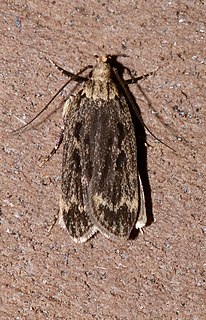Carodista melicrata is a moth in the family Lecithoceridae. It was described by Edward Meyrick in 1910. It is found in Assam, India.
Frisilia compsostoma is a moth in the family Lecithoceridae. It was described by Edward Meyrick in 1921. It is found in the Democratic Republic of the Congo's former Katanga Province and in Zimbabwe.
Frisilia melanardis is a moth in the family Lecithoceridae. It was described by Edward Meyrick in 1910. It is found on Borneo.
Frisilia procentra is a moth in the family Lecithoceridae. It was described by Edward Meyrick in 1916. It is found in southern India.
Frisilia senilis is a moth in the family Lecithoceridae. It was described by Edward Meyrick in 1910. It is found in southern India.
Frisilia strepsiptila is a moth in the family Lecithoceridae. It was described by Edward Meyrick in 1910. It is found in southern India.
Frisilia sulcata is a moth in the family Lecithoceridae. It was described by Edward Meyrick in 1910. It is found in Nepal and Assam, India.
Frisilia verticosa is a moth in the family Lecithoceridae. It was described by Edward Meyrick in 1914. It is found in southern India.
Frisilia dipsia is a moth in the family Lecithoceridae. It was described by Edward Meyrick in 1910. It is found in Sri Lanka.
Frisilia rostrata is a moth in the family Lecithoceridae. It was described by Edward Meyrick in 1906. It is found in Sri Lanka.
Frisilia sejuncta is a moth in the family Lecithoceridae. It was described by Edward Meyrick in 1929. It is found in southern India and Sri Lanka.
Frisilia triturata is a moth in the family Lecithoceridae. It was described by Edward Meyrick in 1914. It is found in the Democratic Republic of the Congo and Malawi.
Spatulignatha hemichrysa is a moth in the family Lecithoceridae. It was described by Edward Meyrick in 1910. It is found in Assam, India.
Timyra pastas is a moth in the family Lecithoceridae. It was described by Edward Meyrick in 1908. It is found in southern India.
Deltoplastis byssina is a moth in the family Lecithoceridae. It was described by Edward Meyrick in 1910. It is found in Sri Lanka.
Deltoplastis propensa is a moth in the family Lecithoceridae. It was described by Edward Meyrick in 1910. It is found in Sri Lanka.

Martyringa xeraula, the Himalayan grain moth, is a moth in the family Lecithoceridae. It was described by Edward Meyrick in 1910. It is found in India (Assam), western China, Japan and North America, where it has been recorded from Louisiana, Texas and from Florida to South Carolina.
Bassarodes is a monotypic moth genus in the family Xyloryctidae. Its only species, Bassarodes siriaca, is found on the Solomon Islands. Both the genus and species were first described by Edward Meyrick in 1910.
Imma nubigena is a moth in the family Immidae. It was described by Edward Meyrick in 1910. It is found on Bali.
Imma synconista is a moth in the family Immidae. It was described by Edward Meyrick in 1918. It is found in Kanara, India.
